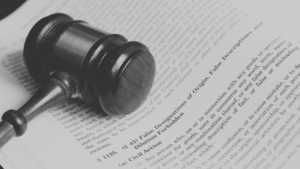Trademark Protection
Trademark registration, licensing, and infringement.
Clients that Trust Our Trademark Protection
Comprehensive Trademark Services for U.S. Businesses
- State trademark application filing
- Federal trademark application filing
- USPTO office action responses
- Trademark clearance searching
- Trademark renewals and maintenance
- Amazon Brand Registry Assistance
- Cease and desist letter drafting and response
- Contract and trademark licensing agreement drafting, review, and negotiation
- Trademark oppositions before the Trademark Trial & Appeal Board (TTAB)
- Uniform Domain-Name Dispute-Resolution Policy (UDRP) litigation
- Anticybersquatting Consuper Protection Act (ACPA) litigation
- Trademark infringement litigation in state or federal court
Check your Trademark Status
What are trademarks?
Trademarks act as source identifiers, meaning they indicate the entity providing certain goods or services. The purpose of using trademarks as source-identifiers is to enable marketplace competition. When consumers have the ability to distinguish one provider of goods from another, they can make informed choices about which provider deserves their purchase. In turn, providers are incentivized to improve their goods or services offerings or live with the consequences of failing to do so. The phrase “trademarks” often encompasses trademarks, services marks, certification marks, house marks, and other source identifiers.
Why is trademark protection important?
Trademark protection is becoming increasingly important. Protecting your brand ensures that others do not take the hard work you have built in your brand. Registration with federal authorities provides additional tools and benefits that allow you to safeguard your brand. Online services and companies continue to place increased reliance on federal trademark protection. The Amazon Brand Registry requires its participants to file a federal trademark application to seek its protections. Implementation of a Brand Indicators for Message Identification (BIMI) record requires possession of a federal trademark registartion to be effective. Possession a federal trademark application is also a crucial step in owning and protecting your domain name from misappropriation.
What steps can you take to protect your trademark?
There are three steps to protecting your trademark: prosecute, utilize, litigate. Prosecution refers to the process of getting your trademark registered with state or federal authorities. Registration with the United States Patent & Trademark Office (USPTO) takes over a year, involves a substantive review of your trademark application, and may involve legal briefing and even a specialized lawsuit called an opposition. After registration, trademarks must be maintained through renewals and other filings with the USPTO.
Utilization often involves licensing a trademark. Brand owners frequently use their trademarks for their own ends, but collaboration among entities often presents its own benefits. Drafting and negotiating a satisfactory licensing agreement could mean the difference between a healthy collaboration and a loss of one’s trademark rights altogether.
Litigation involves enforcing or defending your trademark rights before a tribunal. This could involve policing the trademark rights you own to make sure others do not use your mark without permission. It also involves defending your rights to use your trademark, or other marks, in ways that are legally permissible. To the extent your trademark rights cross paths with another form of property, like domain names, trademark litigation my involve those other forms of property, too.
View our trademark services to the left. We can help protect your brand every step of the way.
Flat Fee Pricing
We strive to provide flat fee pricing to all of our clients whenever possible. Protecting your trademarks with us provides stability and predictability.
Request a Consultation
We provide informative consultations for clients eager to receive professional trademark protection.
Meet Our Trademark Attorney
There’s no substitute for experience and skill when selecting a trademark attorney. Learn more about an attorney that can provide you ironclad protection.
Trademark Prosecution Packages
Starter
-
Protectability Review
-
Filing Basis Analysis
-
Application Drafting / Filing
-
Domestic Filing Bases
Intermediate
-
Protectability Review
-
Filing Basis Analysis
-
Application Drafting / Filing
-
Domestic Filing Bases
-
International Filing Bases
-
Simple Clearance Searching
-
Office Action Responses (non-substantive refusals)
Complete
-
Protectability Review
-
Filing Basis Analysis
-
Application Drafting / Filing
-
Domestic Filing Bases
-
International Filing Bases
-
Comprehensive Clearance Searching
-
Office Action Responses (all refusals)
-
Opposition Defense (discounted rate)
-
Amendment to Allege Use Filing
-
Statement of Use Filing
-
Specimen Analysis
-
Free Mark Monitoring (1 year)
Trademark Prose is our blog about trademark law. Learn the ins and outs of trademark applications, office actions, and trademark infringement. Click on a post below.
Clients that Trust Our Trademark Protection
What are trademarks?
Trademarks act as source identifiers, meaning they indicate the entity providing certain goods or services. The purpose of using trademarks as source-identifiers is to enable marketplace competition. When consumers have the ability to distinguish one provider of goods from another, they can make informed choices about which provider deserves their purchase. In turn, providers are incentivized to improve their goods or services offerings or live with the consequences of failing to do so. The phrase “trademarks” often encompasses trademarks, services marks, certification marks, house marks, and other source identifiers.
Why is trademark protection important?
Trademark protection is becoming increasingly important. Protecting your brand ensures that others do not take the hard work you have built in your brand. Registration with federal authorities provides additional tools and benefits that allow you to safeguard your brand. Online services and companies continue to place increased reliance on federal trademark protection. The Amazon Brand Registry requires its participants to file a federal trademark application to seek its protections. Implementation of a Brand Indicators for Message Identification (BIMI) record requires possession of a federal trademark registartion to be effective. Possession a federal trademark application is also a crucial step in owning and protecting your domain name from misappropriation.
What steps can you take to protect your trademark?
There are three steps to protecting your trademark: prosecute, utilize, litigate. Prosecution refers to the process of getting your trademark registered with state or federal authorities. Registration with the United States Patent & Trademark Office (USPTO) takes over a year, involves a substantive review of your trademark application, and may involve legal briefing and even a specialized lawsuit called an opposition. After registration, trademarks must be maintained through renewals and other filings with the USPTO.
Utilization often involves licensing a trademark. Brand owners frequently use their trademarks for their own ends, but collaboration among entities often presents its own benefits. Drafting and negotiating a satisfactory licensing agreement could mean the difference between a healthy collaboration and a loss of one’s trademark rights altogether.
Litigation involves enforcing or defending your trademark rights before a tribunal. This could involve policing the trademark rights you own to make sure others do not use your mark without permission. It also involves defending your rights to use your trademark, or other marks, in ways that are legally permissible. To the extent your trademark rights cross paths with another form of property, like domain names, trademark litigation my involve those other forms of property, too.
View our trademark services to the left. We can help protect your brand every step of the way.
Comprehensive Trademark Services for U.S. Businesses
- State trademark application filing
- Federal trademark application filing
- USPTO office action responses
- Trademark clearance searching
- Trademark renewals and maintenance
- Amazon Brand Registry Assistance
- Cease and desist letter drafting and response
- Contract and trademark licensing agreement drafting, review, and negotiation
- Trademark oppositions before the Trademark Trial & Appeal Board (TTAB)
- Uniform Domain-Name Dispute-Resolution Policy (UDRP) litigation
- Anticybersquatting Consuper Protection Act (ACPA) litigation
- Trademark infringement litigation in state or federal court
Flat Fee Pricing
We strive to provide flat fee pricing to all of our clients whenever possible. Protecting your trademarks with us provides stability and predictability.
Request a Consultation
We provide informative consultations for clients eager to receive professional trademark protection.
Trademark Prosecution Packages
Starter
-
Protectability Review
-
Filing Basis Analysis
-
Application Drafting / Filing
-
Domestic Filing Bases
Intermediate
-
Protectability Review
-
Filing Basis Analysis
-
Application Drafting / Filing
-
Domestic Filing Bases
-
International Filing Bases
-
Simple Clearance Searching
-
Office Action Responses (non-substantive refusals)
Complete
-
Protectability Review
-
Filing Basis Analysis
-
Application Drafting / Filing
-
Domestic Filing Bases
-
International Filing Bases
-
Comprehensive Clearance Searching
-
Office Action Responses (all refusals)
-
Opposition Defense (discounted rate)
-
Amendment to Allege Use Filing
-
Statement of Use Filing
-
Specimen Analysis
-
Free Mark Monitoring (1 year)






